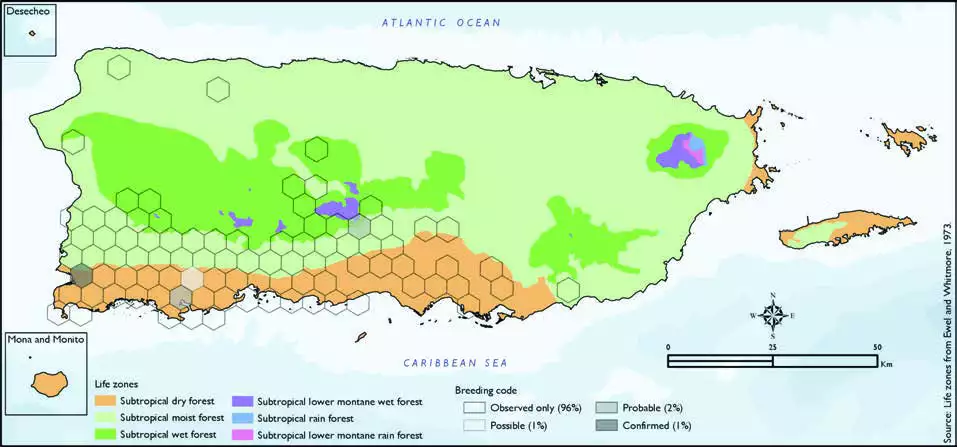Turkey Vulture
Description
The turkey vulture (Cathartes aura), also known in some North American regions as the turkey buzzard (or just buzzard), and in some areas of the Caribbean as the John crow or carrion crow, is the most widespread of the New World vultures. One of three species in the genus Cathartes of the family Cathartidae, the turkey vulture ranges from southern Canada to the southernmost tip of South America. It inhabits a variety of open and semi-open areas, including subtropical forests, shrublands, pastures, and deserts.
Distribution & Habitat
The Turkey Vulture occurs throughout most of the
Western Hemisphere including
the West Indies, where it is
common on Cuba, Jamaica, the
northern Bahamas, northeastern
Hispaniola, and Puerto Rico
(Raffaele and others 1998). It
was reportedly introduced from Cuba to Puerto Rico in the late
19th century (Santiago-Valentin 1997), and it is now commonly
seen in the open country of the
southcentral and southwestern
regions (Biaggi 1997), especially
from Ponce to Cabo Rojo (Oberle
2018). However, it has also been
seen in the northwestern region
between the municipalities of
Moca and Isabela (Lizardi 2003).
Census results indicate that its
abundance decreases from west
to east along the southern coastal
plain of the island (Santana
and others 1986). This species
habitat includes open areas such
as grasslands, coasts, pastures,
dry forests, farming areas (Oberle
2018), scrublands, towns, and
even garbage dumps (Raffaele and others 1998), but it only
comes down to rest on trees or
cliffsides. In Puerto Rico, Turkey
Vultures are most abundant in
the subtropical dry forest life
zone of the southern region
(Santana and others 1986). The
atlas fieldwork yielded a total of
190 records within 89 hexagons
or 19 percent of the 479 total
hexagons (see map). Of the 89
hexagons where this species
was found, breeding met the
atlas definition of confirmed in
1 percent (1) of the hexagons,
probable in 2 percent (2), and
possible in 1 percent (1), while
the species was observed in 96
percent (85) of the hexagons but
without evidence of breeding
(see map). Turkey Vulture distribution. The map shows the highest breeding code by hexagon and overlaying the ecological life zones in
Puerto Rico. Note: percentages may not total 100 due to rounding. 167Turkey Vulture/Aura Tiñosa

Breeding Habits
Previously published reports indicate that the Turkey Vulture
breeds primarily from February
to April, but it may breed
throughout the year (Raffaele
and others 1998). The nest can
be an unmodified rocky ledge,
tree stump, cave (Oberle 2018),
or a shallow depression on
the ground under vegetation
(Raffaele and others 1998). Atlas
results show that this species
breeds during April and May, and
that the breeding activity takes
place within subtropical dry and subtropical wet forest life zones
(see chart). Results show that this
species breeds mostly within the
subtropical dry forest life zone
(75 percent of the hexagons)
(see table), but it may also
breed at higher elevations within
subtropical wet forest life zones
(25 percent of the hexagons)
(see table and map).
Conservation
The current population trend of the Turkey Vulture is described
as stable, and it is currently
listed as a species of least concern by the IUCN (BirdLife
International 2018). Locally, this
species is not listed in any of the
threatened categories of PRDNER
and USFWS. In Puerto Rico, the
Turkey Vulture has a protected
habitat in land of 5 percent or
5 km2 of the total area covered by the hexagons where evidence
of breeding was found for this
species (96 km2).
Related Species
Family:
vulture